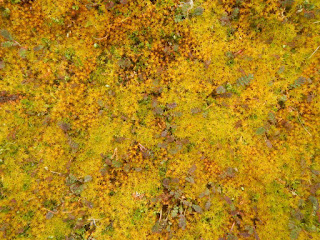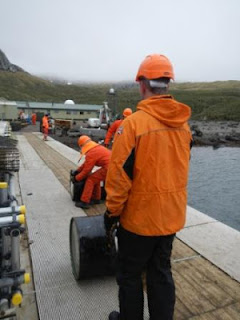Time on Bird Island seems to go disproportionately fast
compared to in the real world! I’ve already been here for over 4 weeks, but I
guess if you never have a day off then the weeks don’t get split up by a
weekend and it’s all becomes a bit hazy.
It’s been another busy couple of weeks on the island. The
Wandering albatross chicks have been fledging like there’s no tomorrow. We only
have 11 chicks left now out of 74 that were here a month ago in our study area.
Unfortunately I haven’t been able to see any fledge, but I’ve seen lots of
practicing. They hold out their wings and do little jumps, which gradually get
bigger. It’s seems to get them pretty excited and you can hear their excited
screeches from miles away. I’ve sat near
ones that I thought might go any minute for ages, but have given up when I get
too cold, or when they fold their wings in and sit back down. I don’t think
they like having an audience, but neither would I, too much pressure!!! When
I come back the following day they are usually gone, so if I’d only waited a
few more minutes (or hours) I might have seen it.
Although the chicks are all departing to head off to the big
blue ocean there are plenty of adults on the island to replace them. Everywhere
you look you can see massive white dots on the landscape. I’m glad they are so
easy to spot as I will have to visit every nest on the island. On the 5
December we started checking all of the adults on nests in the study area each
day to see if they had laid an egg. We got our first egg on 10 December and it
was absolutely huge!!! I got a picture with my hand to show just how massive
they are- they weigh around half a kilogram and are around 130mm long. They are
quite pretty eggs mainly creamy but with nice red marking at one end (it varies
a lot between birds). I have been recording the locations of each nest, the
identity of the parent birds, and taking the weight, length and width of the
egg. So far we’ve had 21 eggs so there should be plenty more on the way!
 |
| A Wandering Albatross egg- HUGE!!! |
Besides the Wandering albatross work I’ve been visiting the
other albatross colonies regularly, and I think I am finally getting to know my
way around them. From tomorrow we start visiting some of them every day instead
of just once or twice a week, as the eggs are due to start hatching, and we
need to get the hatching dates of 80 chicks in each colony.
Some of the Brown Skua’s
on the island had GLS tags put on them last year and it’s now time to
retrieve them. We’ve done pretty well and have gotten 18 back out of 23. They
are not at all easy to get as Skuas are very intelligent birds and when they
have been caught once they don’t make it so easy next time. We have used
various methods including just slowly moving towards the nest and catching
them, using a net (like a fishing net), and using a noose pole. The noose pole
seemed to work best for the most wary birds but I doubt it would again! Skuas
also like to divebomb you so I have had a few occasions when I’ve been face
down in the tussac as the bird swoops down and I can feel its wing sweeping
over the back of my head. Luckily I’ve managed to avoid a full on collision but
they can be pretty feisty.
 |
| Close up of some of the moss on the island |
So that is the main work that I’ve been doing over the last
couple of weeks but I thought it might be interesting to let you know some of
the other things that have been going on around the island.
The first piece of exciting news is that I saw a WHALE just
off the coast of the island. Tamsin, Jen and I were taking a break after
scaling one of the many hills on the island, when I spotted spray shoot into
the air from a blow hole, we all eagerly watched and saw the tail come up into
the air and descend into the depths. Unfortunately we had no time to get any
pictures as we only saw it twice but it was lovely to see a whale so close.
Secondly I saw my first ICEBERG (and not of the salad
variety)! This isn’t quite as exciting as it sounds because it was pretty much
on the horizon so I couldn’t see it very well. Nevertheless it was really cool
to see and hopefully the currents will bring it a bit closer. Apparently last
year an iceberg made contact with the island, so it was thousands of years old
ice in the G and T’s for a while.
The beach outside the base is still covered with seals but
there are now a lot more puppies than adults. The females have started heading
out to sea to feed for a few days and then returning to feed the pups. The pups
seem to like being close to our base and a couple of times I’ve found them
sleeping directly outside of the front door. They are so cute and when they try
to be fierce and growl at you they are even cuter. Last night I met a very
friendly pup underneath the bench out front, who really enjoyed having his
belly rubbed, and kicked his back flipper, like when you scratch a dog! It was
hilarious! You still have to be careful though as you do not want to be
bitten even by a pup. Seals have extremely filthy mouths and if you get bitten
you need lots of antibiotics.
Most afternoons the seal guys work on the puppies outside
the base, so I’ve been helping “puppy cuddling”- holding the puppies while they
get measured and weighed. I guess like children you get some that are good as
gold and go to sleep in your arms, and then those with attitude who twist and
try to bite you, and then those with a weak bladder who make a huge mess of
your overalls. Luck of the draw!
The puppies have started exploring a bit more and have
started climbing up the stairs and go round in little puppy gangs- very funny!
 |
| Seal love (I don't think it's all that consensual though!) |
The male seals are still as grumpy as ever and I’ve had a
couple of close encounters which resulted in me running as fast as I could away
from them. They are speedy when they want to be! It’s like walking between
sleeping bears, and hoping you don’t wake them up as you sneak past- often
though they do wake up! There is still a lot of fighting going on between the
males for females, and over the last few days the number of dead males around
the base has been increasing. They don’t last long as the Giant Petrels , Skuas
and even the ducks make light work of them! Some days there are intestines everywhere! It sounds grim but
it’s just the reality of life for the seals. It’s more upsetting to see the
dead pups but not everyone can survive.
 |
| A lot of the seals are becoming bird food! |
So on that depressing note I’d better change the subject! I
saw my first ducklings today which is not an easy task as they dart through the
tussac as soon as they hear you coming, they are little bundles of black fluff-
one of them was mistaken for a potential rat- which would be disastrous for the
island, but luckily just a little duckling!
The South Georgia Pipit chicks have also been fledging the nests and it
is so lovely to hear the pipits singing away as they fly up above the tussac-
it really makes it feel like Spring.
It’s not all work though (well mostly it is), we’ve had a
couple of social events- mainly film nights and on Saturday we had a darts
match against another base, Signy. We couldn’t get the video working so had to
settle for exchanging scores on msn messenger. All I can say is we definitely
need more practice and we now have to provide Signy with a crate of beer the
next time the ship goes there.
 |
| Macaroni Penguin |
 |
| La Roche our highest peak |
 |
| Trip over to the east side of the island that is a lot more rocky. |
Tamsin made mulled wine and mince pies so it is starting to
feel a little more Christmassy. We also put up our Christmas tree (which is
hideous) and the rest of the decorations which I think were stolen from the
80’s! The saving grace is the purple sparkly penguin at the top of the tree.































